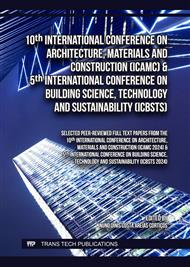[1]
Buonamici, F., Carfagni, M., Furferi, R., Volpe, Y., & Governi, L. (2020). Generative Design: An Explorative Study. Computer-Aided Design and Applications, 18(1), 144-155.
DOI: 10.14733/cadaps.2021.144-155
Google Scholar
[2]
Quiñones, D., Ojeda, C., Herrera, R. F., & Rojas, L. F. (2024). UXH-GEDAPP: A set of user experience heuristics for evaluating generative design applications. Information and Software Technology, 168, 107408.
DOI: 10.1016/j.infsof.2024.107408
Google Scholar
[3]
Zhang, L., Li, Z., & Zheng, Y. (2024). An interactive generative design technology for appearance diversity-Taking mouse design as an example. Advanced Engineering Informatics, 59, 102263.
DOI: 10.1016/j.aei.2023.102263
Google Scholar
[4]
Loos, L., Verbeeck, K., & De Laet, L. (2019). Data Visualisation as a Tool for Informed Structural Design. Computer-Aided Design, 115, 267-276.
DOI: 10.1016/j.cad.2019.06.003
Google Scholar
[5]
Chen, J., Shao, Z., Zhu, H., Chen, Y., Li, Y., Zeng, Z., Yang, Y., Wu, J., & Hu, B. (2023). Sustainable interior design: A new approach to intelligent design and automated manufacturing based on Grasshopper. Computers & Industrial Engineering, 183, 109509.
DOI: 10.1016/j.cie.2023.109509
Google Scholar
[6]
Tedeschi, A. (2011). "Intervista a David Rutten". MixExperience Tools1 (in Italian and English). Naples, Italy: MixExperience. 28-29.
Google Scholar
[7]
Kandikjan, T., Djokikj, J., Mircheski, I., & Angeleska, E. (2022). Integrating parametric design and additive manufacturing knowledge in industrial design education. Materials Today: Proceedings, 70, 687-693.
DOI: 10.1016/j.matpr.2022.10.124
Google Scholar
[8]
Holzer, D. (2016). Design exploration supported by digital tool ecologies. Automation in Construction, 72, 3-8.
DOI: 10.1016/j.autcon.2016.07.003
Google Scholar
[9]
Jabi, W., Soe, S., Theobald, P., Aish, R., & Lannon, S. (2017). Enhancing parametric design through non manifold topology. Design Studies, 52, 96-114.
DOI: 10.1016/j.destud.2017.04.003
Google Scholar
[10]
Chen, M.-T., Zuo, W., Chen, Y., Zhao, O., Cheng, B., & Zhao, J. (2024). Parametric topology optimization design and analysis of additively manufactured joints in spatial grid structures. Engineering Structures, 300, 117123.
DOI: 10.1016/j.engstruct.2023.117123
Google Scholar
[11]
Yu, Z., Dai, H., & Shi, Z. (2022). Structural form finding of bending components in buildings by using parametric tools and principal stress lines. Frontiers of Architectural Research, 11(3), 561-573.
DOI: 10.1016/j.foar.2021.11.004
Google Scholar
[12]
Sommese, F., Hosseini, S. M., Badarnah, L., Capozzi, F., Giordano, S., Ambrogi, V., & Ausiello,G. (2024). Light-responsive kinetic façade system inspired by the Gazania flower: A biomimetic approach in parametric design for daylighting. Building and Environment, 247, 111052.
DOI: 10.1016/j.buildenv.2023.111052
Google Scholar
[13]
Aguilar-Carrasco, M. T., Acosta, I., & Domínguez-Amarillo, S. (2023). CircaLight, a new circadian light assessment tool for Grasshopper environment: Development and reliability testing. Journal of Building Engineering, 71, 106527.
DOI: 10.1016/j.jobe.2023.106527
Google Scholar
[14]
Brown, N. C., Jusiega, V., & Mueller, C. T. (2020). Implementing data driven parametric building design with a flexible toolbox. Automation in Construction, 118, 103252.
DOI: 10.1016/j.autcon.2020.103252
Google Scholar
[15]
Nazidizaji, S., Tome, A., & Regateiro, F. (2015). Investigation about the Feasibility and Impediments of TRIZ Application in Architectural Design Process. Procedia Engineering, 131, 651- 660.
DOI: 10.1016/j.proeng.2015.12.344
Google Scholar
[16]
Condit, C. W., & Salvadori, M. (1981). Why Buildings Stand Up: The Strength of Architecture. Technology and Culture, 22(4), 790.
DOI: 10.2307/3104583
Google Scholar
[17]
Loos, L., Verbeeck, K., & De Laet, L. (2019). Data Visualisation as a Tool for Informed Structural Design. Computer-Aided Design, 115, 267-276.
DOI: 10.1016/j.cad.2019.06.003
Google Scholar
[18]
Khakzand, M. & Mozaffar, F. (2008). Architectural design process in the technology age. International Journal of Engineering Sciences, 19.
Google Scholar
[19]
Park, E. J., Lee, K., & Kang, E. (2023). The impact of research and representation of site analysis for creative design approach in architectural design studio. Thinking Skills and Creativity, 48, 101271.
DOI: 10.1016/j.tsc.2023.101271
Google Scholar
[20]
Stals, A., Jancart, S., & Elsen, C. (2021). Parametric modeling tools in small architectural offices: Towards an adapted design process model. Design Studies, 72, 100978.
DOI: 10.1016/j.destud.2020.100978
Google Scholar
[21]
Oxman, R. (2017). Thinking difference: Theories and models of parametric design thinking. Design Studies, 52, 4-39.
DOI: 10.1016/j.destud.2017.06.001
Google Scholar
[22]
Nathan, M. (2012). LunchBox. https://apps.provingground.io/lunchbox/.
Google Scholar
[23]
Hillier, B., Hanson, J., Peponis, J. (1984). What do we mean by building function? Designing for Building Utilization, Ed. Powell J (Spon, London), 61-72.
Google Scholar
[24]
Wang, P. (2010). Research on Moving Line Design and Spatial Organization of Modern Commercial Pedestrian Block. Ph.D. Thesis, Harbin Institute of Technology, Harbin, China.
Google Scholar
[25]
Garba, S. B., & Hassanain, M. A. (2004). A review of object-oriented cad potential for building information modelling and life cycle management. The 1st ASCAAD International Conference, e- Design in Architecture, KFUPM, Dhahran, Saudi Arabia, December, 343-359.
Google Scholar
[26]
Thomas, D. (2020). Polygonal and NURBS Modeling: What's The Difference? https://conceptartempire.com/polygonal-vs-nurbs/.
Google Scholar


